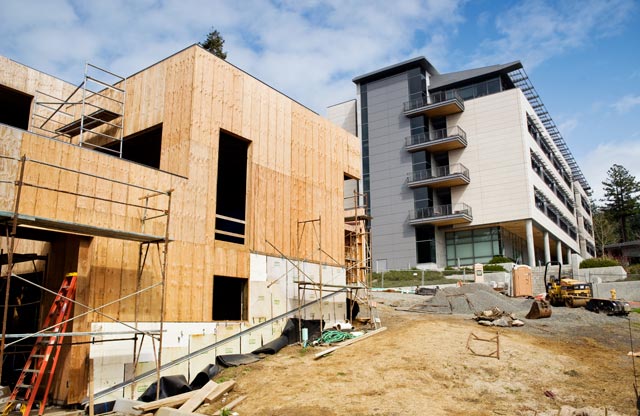
"We moved to the University Annex in the summer of 1992. We've been talking about a new building for 15 years," says Peter Lehman, director of the Schatz Lab.
Arne Jacobson, the Schatz Lab's co-director, appreciates its current facility, but he too is excited to move. "The space that we're in, although it has served us well, is a very beat up building," he says.
Fittingly, the new facility is being built to meet LEED Gold standards for environmentally sensitive design. It will have about twice the square footage of the current location, and it will also have a more central campus location, right across from the Behavioral and Social Sciences building.
"We really wanted to be part of the University. We wanted a location where students could easily come and go," Lehman says. "It puts us next to CCAT. It puts us close to the engineering building. And we're surrounded by redwood forest, but it's still sunny. It's a picturesque site."
Of course, none of it would have been possible without Dr. Louis Schatz, who created an endowment at HSU to support the Schatz Energy Research Center program and gave additional funds for other projects.
The endowment, which is overseen by the HSU Advancement Foundation, continues to provide funds for various Schatz Lab projects. In fact, a significant portion of the new building is being funded by earnings from the Schatz investments.
"It's a huge investment and it's a dream come true," Lehman says.
Over the years, projects at the Schatz Lab have ranged from the first fuel cell car utilizing a proton exchange membrane to the Rural Alaska Power Project, which brought power to remote, off-grid households. Recent projects include a hydrogen fueling station on campus, and the testing of two hydrogen powered Toyota vehicles, as well as bringing energy efficient lighting to Sub-Saharan Africa.
Developing the building from the ground up, including picking a site and deciding its building specifications was a long, involved process. But Lehman and Jacobson are grateful for all the assistance they received from across campus.
Lehman is also glad that the construction is having a positive effect on the local community. "One of the things I'm happy about is that the builders are local," he says. "We were able to keep that money and those jobs in the community."
Construction, which began last March, is scheduled to be completed this summer. By the fall semester, the Schatz Lab is expected to be completely moved into its new home. As the year-long project winds down, anticipation for its opening is growing, and plans for a gala opening are set for early fall.
"I feel really grateful to be a part of this. The world has a lot of problems. It feels good to be helping. I think all of us here feel that way," Lehman says. "I would have never imagined 20 years ago we'd be where we are now. But here we are."